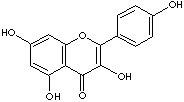|
KAEMPFEROL |
|
3,4',5,7-Tetrahydroxyflavone; Robigenin; 3,5,7-Trihydroxy-2-(4-hydroxyphenyl)-4H-1-benzopyran-4-one; 3,5,7-Trihydroxy-2-(4-hydroxyphenyl)-4H-1-benzopyran-4-one; 5,7,4'-Trihydroxyflavonol; C.I. 75640; Campherol; Indigo Yellow; Kaempferol; Kaempherol; Nimbecetin; Pelargidenolon; Populnetin; Rhamnolutein; Rhamnolutin; Trifolitin; |
|
|
| PRODUCT IDENTIFICATION |
|
|
CAS RN |
520-18-3 |
|
EINECS RN |
208-287-6 |
|
FORMULA |
C15H10O6 |
|
MOLE WEIGHT |
286.24 |
|
CHEMICAL FAMILY |
Bioflavonoid |
| CATEGORIES | Extractives and their physically modified derivatives |
|
|
| PHYSICAL AND CHEMICAL PROPERTIES |
|
|
PHYSICAL STATE |
yellow crystalline powder |
|
MELTING POINT |
276-278 C |
|
BOILING POINT |
610 C |
|
DENSITY |
|
|
SOLUBILITY IN WATER |
Slightly soluble (soluble in ethanol) |
|
pH |
|
|
VAPOR DENSITY |
|
|
REFRACTIVE INDEX |
|
|
FLASH POINT |
|
|
|
| STABILITY AND REACTIVITY | |
| STABILITY | Stable under normal conditions. |
|
INCOMPATIBILITIES |
Strong oxidizing agents |
| DECOMPOSITION PRODUCTS |
Carbon oxides |
| POLYMERIZATION | |
|
TOXICOLOGICAL |
|
|
|
| SAFETY |
|
|
HAZARD NOTES |
Toxic if swallowed. |
|
EYE |
May cause eye irritation. |
|
SKIN |
May be harmful if absorbed through skin. May cause skin irritation. |
|
INGESTION |
Toxic if swallowed. |
|
INHALATION |
May be harmful if inhaled. May cause respiratory tract irritation. |
|
TARGET ORGANS |
Liver, Kidney, Nerves., Heart |
|
CHRONIC |
|
|
|
| TRANSPORT & REGULATORY INFORMATION |
|
|
UN NO. |
2811 |
| HAZARD CLASS |
6.1 |
| PACKING GROUP |
III |
| HAZARD SYMBOL |
T |
|
RISK PHRASES |
25 |
|
SAFETY PHRASES |
45 |
|
|
| EXTERNAL LINKS & GENERAL INFORMATION | ||||||||||||||||||||||||||||||||||||||||||||||||||||||||
|
Wikipedia Linking: http://en.wikipedia.org/wiki/Kaempferol Keampferol is a strong antioxidant and helps to prevent oxidative damage of our cells, lipids and DNA. Kaempferol seems to prevent arteriosclerosis by inhibiting the oxidation of low density lipoprotein and the formation of platelets in the blood. Studies have also confirmed that kaempferol acts as a chemopreventive agent, which means that it inhibits the formation of cancer cells. An in vitro study by Jan Kowalski et al (Pharmacological Reports, 2005) showed that kaempferol inhibits monocyte chemoattractant protein (MCP-1). MCP-1 plays a role in the initial steps of atherosclerotic plaque formation. The flavonoids kaempferol and quercetin seems to act synergistically in reducing cell proliferation of cancer cells, meaning that the combined treatments with quercetin and kaempferol are more effective than the additive effects of each flavonoid. This was a conclusion from a study by ML Ackland et al (In Vivo, Feb 2005) titled "Synergistic antiproliferative action of the flavonols quercitin and kaempferol in cultured human cancer cell lines"". A study "Inhibition of P-glycoprotein function and expression by kaempferol and quercetin" by the Chiang Mai University, Thailand, found that kaempferol can help to fight cancer because it reduces the resistance of cancer cells to anti-cancer drugs such as vinbalstine and paclitaxel. (http://www.phytochemicals.info/)Kaempferol is one of the most widespread natural flavonoids that have C6-C3-C6 structure with a single hydroxyl group attathed to the B ring. It can be isolated from Delphinium, Witch-hazel, grapefruit, gingko biloba, St. John's wort., and other plant sources. It is a yellow crystalline solid with a melting point of 276-278 C and a high boiling point (610 C) . It is slightly soluble in water, and soluble in alcohol and diethyl ether.
|
|
|
| SALES SPECIFICATION |
|
|
APPEARANCE |
yellow crystalline powder |
| ASSAY |
98.0% min |
|
LOSS ON DRYING |
2.0% min |
|
HEAVY METALS |
10ppm max |
| ARSENIC |
1ppm max |
|
SULFATED ASH |
1.0% max |
| PARTICLE SIZE | 80mesh (100%) |
| MICROBIOLOGICAL TESTS |
Total plate count:
1000CFU/g mac Yeast and mold: 100CFU/g Salmonella: negative E.Coli: negative Staphylococcus: negative P.Aeruginosa: negative |
|
|
| PACKING |
|
|
|
|
| PRICE INFORMATION |
